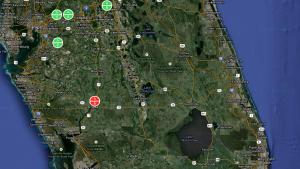Stressors and impacts
The Florida morning was cool and damp; raindrops from a predawn shower shone on the strawberry leaves like little cabochon diamonds. Ferris Farms General Manager Dudley Calfee, surveying his strawberry crop, knew that if the weather warmed up before the raindrops dried, fruit rot could take hold. Instead of gleaming red berries to take to market, he would have the moldy grey fuzz of a disaster on his hands. The subtropical climate of Florida makes growing strawberries a constant battle against at least two kinds of fruit rot: anthracnose and Botrytis.
Traditionally, Florida strawberry farmers sprayed fungicide to prevent rot, spraying every week or 10 days throughout the growing season just in case rot was even thinking of appearing. The costs of spraying—including fungicides, equipment, and personnel—cut into profits, and also gave Florida strawberries a reputation that doesn’t square with customers’ demand for more natural berries.
Changing tactics
Calfee used to be a spray-every-week farmer until he got a call from Natalia Peres, a plant disease scientist with the Gulf Coast Research and Education Center at the University of Florida. Peres and her team were researching strawberry disease and testing a system that would allow growers to raise strawberries with less fungicide—something that saves time, money, and helps the fungus avoid developing resistance to the chemicals. The system they developed uses an algorithm to process temperature data, leaf wetness readings, humidity, and the local weather forecast together to tell if conditions will be favorable for fruit rot fungus to grow. Using the algorithm, their system predicts whether spraying with fungicide is necessary.
Calfee started by trusting only a small portion of his crop to the Strawberry Advisory System, but found that the test plot grew no more anthracnose or Botrytis fungus than the rest of his normally-sprayed berries. By the fifth year, the results were so impressive that Peres had to convince Calfee to keep spraying one quarter-acre test plot weekly as a control in their experiment. He only sprayed the rest of his 83 acres when the science team sent him an alert.
Saving money with science
Florida farmers grow strawberries on about 11,000 acres of land. Peres’ team estimates that spraying only when needed, and spraying the best product for the problem, can save up to $400 per acre per year. If all growers in Central Florida used the system for their 7,500 acres of winter strawberries, they could reduce their costs by up to $3 million per year.
Calfee says that, in addition to saving money, he appreciates that he can now say he grows strawberries that are as close to organic as possible in Florida—a claim he knows his customers appreciate. At first there was quite a bit of reluctance among neighboring farmers to adopt the new system, but after five years word spread about the system's success. Just over half of Florida's strawberry growers have adopted the Strawberry Advisory System in its first decade of existence, reducing their use of fungicides by 30–50 percent.
Even with its success, the Strawberry Advisory System is just one tool. As global warming and climate variability affect the climate and weather patterns across the United States, growers will need to continue to adapt to stay ahead of the curve and stay climate-smart.


